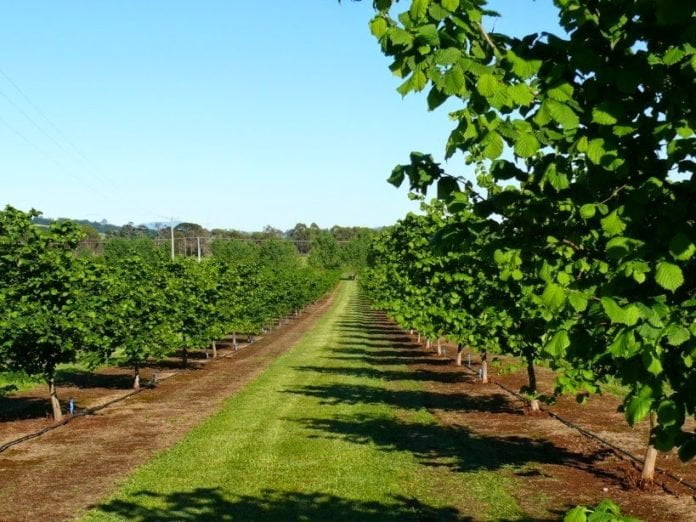Lack of labor in Georgia’s agricultural sector worries many farmers during the harvesting season. In an interview with EastFruit farmers said that large farmers are more likely to find the workers they need than small ones but hiring seasonal workers has become more expensive this year for all. Some growers see mechanized harvesting as a solution to this problem.
Farmers cited working-age immigration as the main reason for labor shortages. According to official statistics, the rural population in Georgia has decreased by 8% over the past 10 years. Local residents prefer to travel to other countries in search of seasonal work, as they expect higher salaries and stable jobs.
Farmers report a 15-29% increase in daily wages for pickers in 2021 compared to 2020. In particular, in the Kakheti region, the daily wage has increased from 30-35 GEL last year to 35-45 GEL ($ 11-14) this season. Salaries have also increased in the Samegrelo region, where the hazelnut harvesting season is at its peak. At the beginning of the season, the daily wage in Samegrelo was 35 GEL, but now some farmers are paying 50 GEL ($ 16) as the demand for labor has increased at a peak. Lack of labor was also a problem for berry growers, who have already completed their main season this year.
Read also: The harvest of hazelnuts in Georgia is hampered by a labor shortage
Since harvesting is the most labor-intensive process in a farm, mechanization may be a solution for some growers. In orchards where harvesting is still done manually, stone fruit, apple and berry producers (other than blueberries) are less likely to mechanize harvesting in the near future. Most likely, large growers of hazelnuts and blueberries will invest in harvesting machines in Georgia.
One of the farmers looking to invest in a harvester is the hazelnut grower Tengiz Dolidze from the Samegrelo region. He is an average farmer with a 20-hectare orchard but believes that even with a medium-sized production, it is worth investing in a harvester.
“The price of a hazelnut harvester depends on its specifics and country of production. There are Italian machines costing 7-10 thousand euros on the market. On a smaller budget, you can buy Turkish ones. These harvesters can replace 35 workers a day and last 15-20 years. Considering my seasonal labor costs, investing in a harvester is financially worthwhile. I will definitely buy it next season.” Dolidze said.
Dolidze has a 5-year-old hazelnut orchard with two more years left until full maturity. Now he needs 20 workers for two weeks to harvest. He pays 50 GEL per day for each employee. Dolidze explained that labor costs will increase in the coming seasons as the orchards mature.
According to Otar Sherozia, head of the Farmers’ Union, which brings together 18 commercial hazelnut growers in Georgia with a total of 1,960 hectares of orchards, almost a third of their members are already using or about to invest in a harvester. Otar Sherozia himself has a 50-hectare walnut orchard, planted 5 years ago. He is considering buying a harvester in two years, when the farm is fully productive.
“I saw how combine harvesters work in Georgia, and the results are good. But before using them, growers must prepare the orchard for it. For the machine to work properly, the surface must be level. It can take a while to prepare it, so they shouldn’t expect just buying a harvester to be enough” he said.
In addition to hazelnut growers, Georgia’s largest blueberry farm, GeorgianBlue, is also set to test the harvester next season. The company owns 35 hectares of blueberry orchards and plans to further expand production. In an interview with EastFruit, a representative of the company, Rati Morchiladze, explained that this season has shown them the inevitability of a shortage of labor. With the company’s plans to expand and increase harvests each year, it will be nearly impossible for them to mobilize the required number of pickers in the near future as they will need to hire hundreds of people in a short period of time.
“Starting next year, we plan to test a combine harvester in some areas of our farm. Despite the hilly landscape, about half of the orchards can be harvested by machines. We hope to harvest high quality blueberries that will be acceptable to the fresh market, but first we need to test how it will work with the varieties we have. Last year we planted 4 hectares of new orchards with various varieties suitable for machine harvesting,” Morchiladze said.
Mechanized harvesting is only one component of farm mechanization. Many growers in Georgia have already mechanized other orchard operations to hire less workers. For example, many apple and stone fruit orchards in Georgia mechanized watering, fertilization and post-pruning branch management, but harvesting and pruning are still manual operations.
The use of the site materials is free if there is a direct and open for search engines hyperlink to a specific publication of the East-Fruit.com website.




